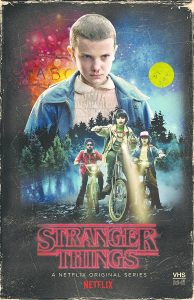The 1980s nostalgia is strong with the 2016 Netflix series “Stranger Things.” The eight-episode first season, which came out in July and rates a staggering 9.0 on IMDB, takes a lot of things we loved about Eighties movies – particularly in the coming-of-age and horror genres – and molds them into what is essentially a six-hour movie that can be enjoyed in two or three sittings.
Back to the 1980s
Creators Matt and Ross Duffer, who had previously penned a few episodes of “Wayward Pines,” tap into an unspoken truism about the beloved films of our childhoods: We re-watch them regularly because we want to spend more time in those worlds, and during that more innocent time. When I see buddies Mike, Dustin, Lucas and Will playing Dungeons & Dragons in Mike’s basement in 1983, I think of the friends in “E.T.” Most viewers think of “Goonies,” which for some reason wasn’t a childhood favorite of mine, although I don’t hate it.
Starting with longer-than-today’s-norm opening credits where letters float into the frame and slowly form the title, the Duffer Brothers wallow in this world. When the mysterious Eleven – an escapee of a secret governmental experimental lab located near tiny Hawkins, Ind. – enters the kids’ lives, we get that classic awkwardness of boys figuring out how to act with a girl in their midst.

“Stranger Things” Season 1 (2016)
Netflix, eight episodes
Creators: The Duffer Brothers
Stars: Millie Bobby Brown, Finn Wolfhard, Winona Ryder
Is Mike attracted to Elle because they have a true connection, or because she’s the only girl he knows? (Apparently, Eleven – with a hospital gown, a bloody nose and an armful of Eggos – was a popular Halloween costume this year among adults.)
Elle lives in a fort in Mike’s basement – “fort” as in blankets draped over a table; I and my sister used to transform the ping-pong table into a fort in our Midwestern basement. Another nice affectation of the times comes when Joyce (Winona Ryder) – the mom of the missing Will – strings up Christmas lights as a way to communicate with her son; she and sheriff Jim Hopper (David Harbour) have to go through the bulbs one by one to find the burned-out culprit that makes the whole string go out. (I never did really understand how that worked.)
Again, I get a slight “E.T.” vibe from mysterious agents who enter the lives of the kids as they probe (or perhaps orchestrate) the strange goings-on. In “E.T.,” it was only from a kid’s perspective that the men in the spaceman-style quarantine suits were ominous, but the Duffers play that note more strongly in “Stranger Things.”
Archetypes in place
Other archetypes include girl-next-door Nancy (Mike’s older sister), who is the middle point of a love triangle with maybe-he’s-not-so-bad boyfriend Steve and nice-guy/loner Jonathan. Among the adults, it’s great to see Ryder back in a major role – indeed, this is her first time as a TV series regular – even though the script gives her only one note to play: The panicked mom.

As Sheriff Hopper, Harbour also plays a familiar but entertaining beat as he starts every day with a cigarette and yesterday’s unfinished beer. Aside from Ryder, the biggest name in the cast is Matthew Modine as the leader of the secret lab.
There’s a pretty decent Stephen King-esque concept running through the series: There exists another dimension that’s the opposite of our reality, and there are assorted portals where one can cross over, including one that’s in the hollowed-out trunk of a tree in the woods.
Basic stuff of nightmares
This other dimension is dimly lit and filled with monsters and slimy webs – a What’s What of childhood nightmares. It must be said, though, that in the midst of this current smorgasbord of horror TV, “Stranger Things” isn’t particularly scary. It’s scary-for-14-year-olds, in that Steven Spielberg way. But that can still be fun.
The conceit of “Stranger Things” reminds me of Robert Rodriguez’s deliberate grindhouse revival movies such as “Planet Terror,” “Death Proof” and the “Machete” pictures. Those films masterfully brought us back to the Seventies, and “Stranger Things” does the same thing for the Eighties.
Admittedly, when I watched these eight episodes, I was constantly noticing the mood and set dressings of the piece, and – while I liked the archetypal characters well enough – the story suffers a bit by comparison. So there’s a portal to another dimension. And so Elle has telekinetic powers. So what? There will be a second season that will probably address those questions (and hopefully allow Ryder to play more acting notes). But when I tune in, it’ll be mainly to take another trip back to the Eighties.

